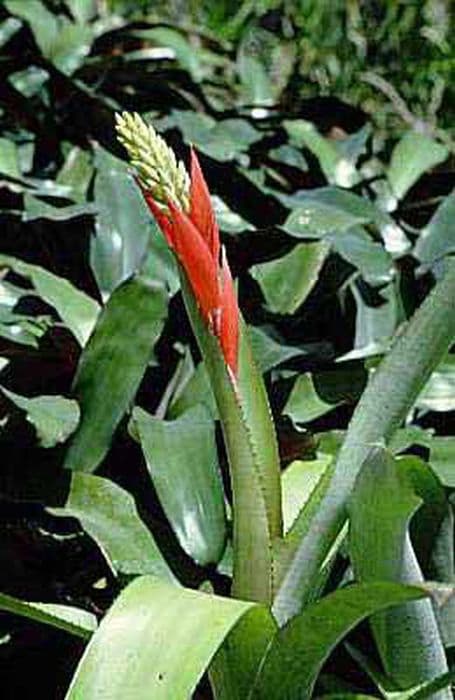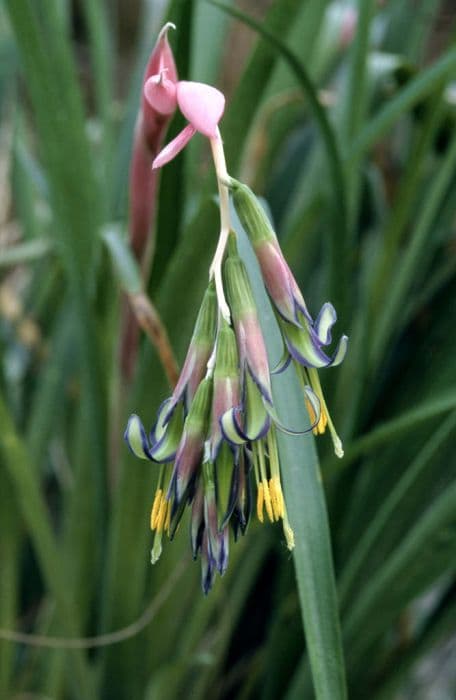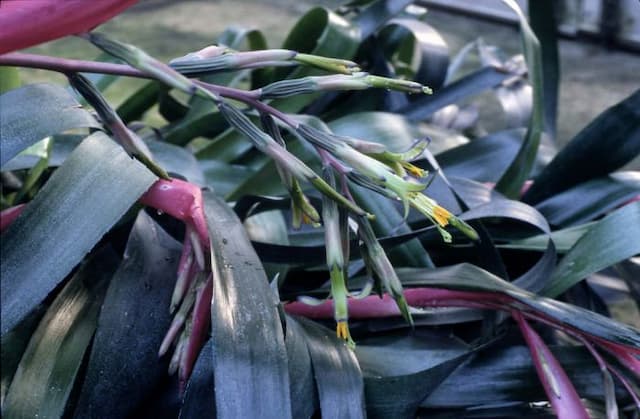Sky plant Tillandsia ionantha from Mexico

ABOUT
Commonly known as the "blushing bride," the plant in question has a striking appearance characterized by a rosette of spiky, narrow leaves. These leaves tend to be a soft, silvery-green color, but as the plant approaches its blooming period, they can change, showcasing vibrant shades of pink and red, giving it the "blushing" descriptor. At the center of the rosette, when it is time to bloom, purple flowers emerge, creating a delightful contrast against the red and pink hues of the changing leaves. The overall visual effect is eye-catching, as the plant boasts a full and lush look despite its compact growth habit. The foliage has a distinctive texture, which adds to its ornamental appeal, as the leaves are often covered with fine scales that give them a slightly fuzzy touch. This unique appearance, along with its changing colors through the blooming cycle, makes the blushing bride a popular choice for both plant aficionados and those looking to add a pop of natural color to their environments.
About this plant
 Names
NamesSynonyms
Sky Plant, Blushing Bride, Air Plant.
Common names
Tillandsia ionantha var. scaposa, Tillandsia ionantha var. stricta.
 Toxicity
ToxicityTo humans
Sky plant (Tillandsia ionantha) is generally considered non-toxic to humans. There are no well-documented reports of poisoning from ingesting this plant, and it is often used decoratively in homes without issue.
To pets
Sky plant is also non-toxic to pets. It is not known to cause any harmful effects if pets ingest parts of this plant. Owners typically grow Tillandsia ionantha without concerns for pet safety regarding toxicity.
 Characteristics
CharacteristicsLife cycle
Perennials
Foliage type
Evergreen
Color of leaves
Green
Flower color
Varies
Height
0.5 feet (15 cm)
Spread
0.5 feet (15 cm)
Plant type
Epiphyte
Hardiness zones
9
Native area
Central America
Benefits
 General Benefits
General Benefits- Decorative Appeal: Tillandsia ionantha, commonly known as the Air Plant, offers unique aesthetic value due to its striking colors and interesting shapes, making it a popular choice for home decor and terrariums.
- Low Maintenance: As an epiphytic plant, it requires no soil and minimal watering, which makes it very easy to care for and maintain.
- Adaptability: Air Plants are adaptable to a wide range of environments and can be displayed in various ways, such as mounted on different surfaces or simply placed in a glass globe.
- Non-Toxic: The Air Plant is safe for households with pets and children, as it is non-toxic and poses no risk if accidentally ingested.
- Long-Lasting: With proper care, Air Plants can live for several years and they often produce offsets or 'pups', which can grow into new plants.
- Teaching Tool: Due to its unique biology, the Air Plant can serve as an educational tool to teach about botany and the diversity of plant life.
 Medical Properties
Medical PropertiesThis plant is not used for medical purposes.
 Air-purifying Qualities
Air-purifying QualitiesThis plant is not specifically known for air purifying qualities.
 Other Uses
Other Uses- Tillandsia ionantha, commonly known as air plant, can be used as a natural art medium for creating living sculptures, where the plants serve as an organic, growing component that evolves over time.
- These air plants can be incorporated into jewelry, such as living brooches, necklaces, or earrings, offering a unique way to wear and showcase live plants.
- Air plants are sometimes used in educational settings, such as classrooms or workshops, to teach botany and plant care, providing a hands-on experience with an easy-to-care-for organism.
- In pet terrariums or vivariums for reptiles and amphibians, Tillandsia ionantha can contribute to a biologically diverse and aesthetically pleasing habitat.
- Due to their small size and minimal root system, air plants are ideal for crafting mobiles and hanging ornaments that bring a touch of greenery to indoor spaces.
- They are often used in event decorations, such as weddings or parties, either as table centerpieces or natural accents in floral arrangements.
- Air plants can add a botanical aspect to handmade greeting cards or gift packaging, serving as a living embellishment that can be planted later.
- Tillandsia ionantha can be used as a natural and renewable resource for model landscaping, providing a realistic plant life in dioramas or architectural models.
- As a muse for artists and photographers, the unique form and vibrant colors of air plants can inspire and be featured in a variety of visual arts.
- In crafting DIY fairy gardens or miniature worlds, air plants serve as low-maintenance foliage, adding a whimsical touch to these small fantasy landscapes.
Interesting Facts
 Feng Shui
Feng ShuiThe Air Plant is not used in Feng Shui practice.
 Zodiac Sign Compitability
Zodiac Sign CompitabilityThe Air Plant is not used in astrology practice.
 Plant Symbolism
Plant Symbolism- Resilience: As an air plant, Tillandsia ionantha can grow without soil, symbolizing adaptability and resilience in challenging environments.
- Independence: Its ability to absorb water and nutrients through its leaves reflects self-reliance and independence.
- Love and Friendship: The natural blush of pink to red hues that the plant develops is often associated with love, affection, and nurturing relationships.
- Eternal Life: This plant's longevity and evergreen nature make it a symbol of immortality and the continuous cycle of life.
- Freedom: The non-reliance on soil also signifies freedom from traditional constraints and the ability to thrive in various conditions.
 Water
WaterThe air plant, commonly known as Tillandsia ionantha, should be watered by soaking in water for about 20-30 minutes every one to two weeks. Shake off any excess water and let it dry upside down so water doesn't collect in the base, as this can cause rot. In drier or hotter climates, they may require more frequent watering, possibly as often as once a week. Ensure that you use about a quarter to half a gallon of water for soaking during each watering session, depending on the size of your collection. Adjust watering frequency based on seasonal humidity; less during humid periods and more when the air is dry.
 Light
LightThe ideal light conditions for the Tillandsia ionantha, or air plant, are bright, indirect sunlight. They're best placed near a window with diffused light or under artificial grow lights, avoiding direct sun which can scorch their leaves. East or west facing windows are often ideal spots, ensuring that the plant receives some morning or late afternoon light without the intense midday rays.
 Temperature
TemperatureTillandsia ionantha, or air plant, thrives in temperatures between 50 to 90 degrees Fahrenheit. It can survive minimum temperatures of no lower than 45 degrees Fahrenheit and should not be subjected to temperatures over 95 degrees Fahrenheit, as extreme temperatures can cause stress and damage. The ideal temperature range for promoting growth and maintaining health is from 70 to 80 degrees Fahrenheit.
 Pruning
PruningPruning Tillandsia ionantha, or air plant, is primarily for aesthetic reasons, to remove any dead or brown leaves. Use sharp scissors to trim any unsightly or damaged leaves. Pruning can be done as needed, but it is best to do it after watering when the leaves are more flexible. The best time to prune is during the growing season in the spring, which can also stimulate new growth.
 Cleaning
CleaningAs needed
 Soil
SoilThe Tillandsia ionantha, commonly known as the Sky Plant, does not require soil as it is an epiphyte that absorbs moisture and nutrients through its leaves. For this reason, there is no soil mix recipe or soil pH necessary for the Sky Plant.
 Repotting
RepottingSky Plant, or Tillandsia ionantha, does not need repotting as it is an air plant and does not grow in soil; it can be mounted on a substrate that does not retain moisture.
 Humidity & Misting
Humidity & MistingSky Plant thrives in high humidity environments, with ideal levels ranging from 50% to 70% to mimic its native tropical habitat.
 Suitable locations
Suitable locationsIndoor
Mount on wood/bark, mist regularly, bright indirect light.
Outdoor
Hang on a tree branch or mount on bark, provide shade and mist.
Hardiness zone
9-11 USDA
 Life cycle
Life cycleTillandsia ionantha, commonly known as the Sky Plant, starts its life cycle as a seed, often dispersed by wind due to its light, fluffy structure. Upon finding a suitable host, such as a tree or rock, the seed germinates and develops into a small plant, using its trichomes to absorb moisture and nutrients from the air. As it matures, it grows into a rosette of silvery-green leaves and eventually produces a striking bloom spike with purple flowers, usually after several years of growth. After flowering, which can last from several days to a few months, the plant will gradually produce offsets, or "pups," around its base. These pups, once large enough, can be separated from the parent plant to grow independently. The original flowering plant typically dies after the pups are well established, completing its life cycle.
 Propogation
PropogationPropogation time
Spring-Summer
Propogation: The air plant, Tillandsia ionantha, native to Mexico, is typically propagated through the division of offsets, also known as "pups." These pups emerge from the base of the mother plant after it flowers. To propagate, you wait until the pup is about one-third to one-half the size of the parent plant, which usually takes a few months post flowering. Gently pull the pup away from the mother plant, making sure to leave some of the base so it can continue to grow. These pups can then be placed on a support or hung in air until they root and grow into mature air plants, continuing the lifecycle of the species. This vegetative method is simple and mirrors the plant's natural reproductive strategy, making it the most popular and successful means of propagation for Tillandsia ionantha.









